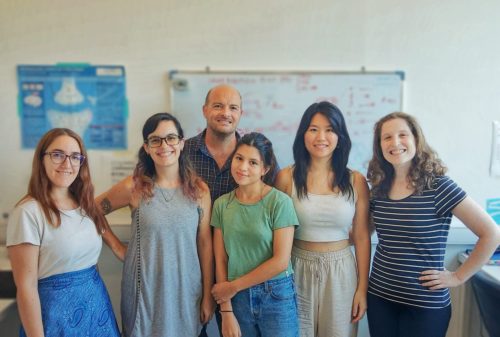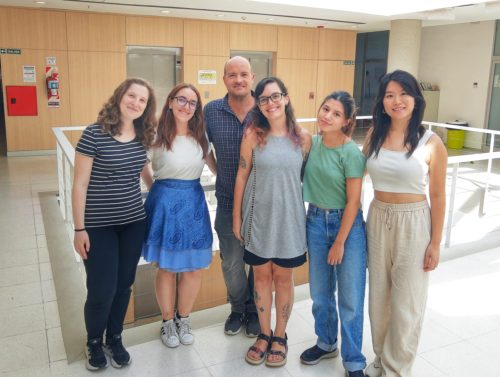Lab meeting with the Soiza-Reilly lab
Posted by the Node, on 12 March 2024
Where is the lab?
Our lab is located at the Instituto de Fisiología, Biología Molecular y Neurociencias from CONICET and University of Buenos Aires within the main campus of the Facultad de Ciencias Exactas y Naturales in Buenos Aires, Argentina. We are embedded in a large and beautiful green area of Buenos Aires facing the giant Rio de la Plata.
Research summary
We are interested in how early postnatal maladaptive development and miswiring of cortico-limbic circuits could enhance our predisposition to develop psychiatric disorders such as anxiety, stress vulnerability and depression in adult life.

Lab roll call
Mariano Soiza-Reilly: I have the huge responsibility (and pleasure) of leading this young team of researchers.
Tamara S. Adjimann: PhD student – I am finishing my PhD thesis on the effects of pharmacologically increased levels of serotonin, induced by postnatal fluoxetine, on the brain morphology and function.
Carla V. Argañaraz: PhD student – I´ve been part of the lab since its early stages, first as an intern and now as a PhD student working on the effects of early adversity on the serotonergic system.
Rocío B. Foltran: Postdoc – I joined the lab to study how hyposerotonergy and stress in early life can have consequences in emotional behavior in adult life.
Grace Wu: Master student – I investigate how a specific serotonin receptor is implicated in the morphological changes in a cortico-limbic circuit produced in an early postnatal stress model.
Melina Maidana: Master student – I’m working on my degree’s thesis, which consists of studying adult mice behavior after treating them with a serotonin receptor antagonist in early stages of their life.
Favourite technique, and why?
Mariano Soiza-Reilly: I’m particularly attached to an immunofluorescent technique called array tomography that is extremely useful to quantitatively explore molecular and fine anatomical features of synaptic circuits. I learned this technique during my first postdoc in Boston more than 10 years ago and since then it has been accompanying me throughout my scientific career.
Apart from your own research, what are you most excited about in developmental and stem cell biology?
Mariano Soiza-Reilly: There are so many great advances in these fields. For instance, current investigations in cortical development combining the use of organoids (or even assembloids!) and transcriptomics are certainly stunning. I´m always fascinated by current advances in the technologies available to obtain hiPSCs from patients and to differentiate them to better understand (and perhaps to treat) many neurological and psychiatric disorders with developmental origins.
How do you approach managing your group and all the different tasks required in your job?
Mariano Soiza-Reilly: I guess a fundamental factor for me is to try to enjoy every aspect of the academic career. I try to transmit this philosophy to students and young collaborators. Of course everyone is different (and this is great in a team!) but it is important to reach a balance of the different tasks to avoid the burnout. I like to think that I’m open and available to all the people in the lab, not only regarding lab life, but also for career advice. In general, we establish clear goals and objectives and then we help each other to reach them timely. We work very much as a family and this is key to maintain a nurturing and relaxing environment that facilitates career development. Having the right scientific collaborators also contributes to keep this atmosphere.
What is the most complicated issue in your job?
Mariano Soiza-Reilly: One of the most demanding tasks for labs like ours, based in peripheral countries, is to obtain international visibility from colleagues based in central countries. Sadly, our countries devote quite small budgets to science and often we have to apply to international calls to try to have access to more realistic budgets for science. This is extremely hard to achieve and only can happen with international visibility and successful collaborative work.
What is the best thing about where you work?
Mariano Soiza-Reilly: Our lab is placed in a new building with a great community of colleagues and students, and surrounded by trees and the waters of the Rio de la Plata. We are immersed in a large scientific community where many young researchers start their scientific careers. It is a huge privilege to be part of that process.
Tamara S. Adjimann: PhD student – The institute is placed in a new building with many facilities that make doing science more comfortable. Our lab is quite spacious and luminous, which makes going to work more pleasurable. Also, we are surrounded by a lovely community that is always looking to make improvements and keep pushing forward for the benefit of all.
Carla V. Argañaraz: PhD student – I think the best thing about our workplace is that we get to be in a pretty quiet place, near an ecological reserve and next to the river, so coming here you get the kind of peace that big cities rarely allow. Of course this would mean nothing without the awesome group of people that always receives you with a smile, they are truly the heart of the community here.
Rocío B. Foltran: Postdoc – I think that it’s the atmosphere, not only because it’s surrounded by nature away from the craziness of the city, but because it’s next to several other scientific institutes and the natural sciences faculty, filled with people who love science as much as we do.
Grace Wu: Master student – The people! The institute has a collaborative environment where everybody is so nice, respectful, patient and always willing to help each other out. Also the building is well maintained and comfortable to work in, and the view from the lab is peaceful and calming, perfect to look at while having a little break.
Melina Maidana: Master student – The comfortable work environment is a remarkable quality of the lab.
What’s there to do outside of the lab?
Mariano Soiza-Reilly: I enjoy doing sports and spending time with my family. Buenos Aires is a beautiful city with many corners to be discovered.
Tamara S. Adjimann: PhD student – There is a lot to do around here. Buenos Aires is one of the most active cities in the world, with many diverse activities to enjoy both during the day and night. There are lots of restaurants and cafés, many parks and museums and lots of places to discover in its surroundings. The people here are very warm and friendly, and will make everything even more enjoyable.
Carla V. Argañaraz: PhD student – Our city is so big and diverse that it offers something to fit every taste. You can find great art museums, usually next to lovely parks where you can take a stroll after. Buenos Aires is filled with cultural activities, from clubs playing local music to jazz clubs all over the city, you can find any genre you want and have a nice drink while listening to some music. There’s also lots of green spaces if chilling and reading there is your thing, and of course, lots of beautiful libraries to find your book companion.
Rocío B. Foltran: Postdoc – Buenos Aires is a very culturally rich city, and I enjoy going to the theater, to the cinema, to eat some delicious meals or to rest in some of the green parks.
Grace Wu: Master student – Buenos Aires is a city that never sleeps, so for the night owls this means open bars, restaurants and clubs till late night! If not, there are many green areas to practice sports or have a little walk, museums, concerts, theaters, markets, cute cafes… you name it! Also, the gastronomy is diverse and great, especially the meat and wine ;)
Melina Maidana: Master student – near Ciudad Universitaria you can go for a walk and visit the “Parque de la memoria”.

Browse through other ‘Lab meeting’ posts featuring developmental and stem cell biology labs around the world.


 (No Ratings Yet)
(No Ratings Yet)